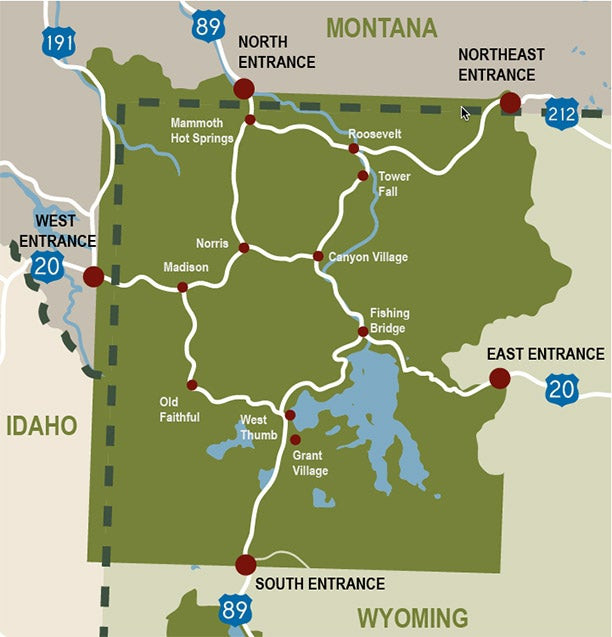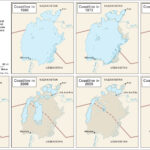Yellowstone National Park, a jewel in the crown of America’s national park system, is renowned for its breathtaking geysers, vibrant hot springs, abundant wildlife, and stunning landscapes. But Where Is Yellowstone Park exactly? This expansive natural wonder is situated in the northwestern United States, primarily within the state of Wyoming. However, its vast reach extends into two neighboring states as well.
While Yellowstone National Park’s official address points to Wyoming, it’s important to understand that this massive park, encompassing a total of 3,472 square miles, actually crosses state lines. Wyoming claims the lion’s share of Yellowstone, hosting approximately 96% of its territory. Venturing north and northwest, about 3% of the park spills into the southern reaches of Montana. Finally, to the west, a small 1% sliver of Yellowstone extends into eastern Idaho.
 Yellowstone Road Map
Yellowstone Road Map
This tri-state location makes Yellowstone uniquely accessible from various directions, offering multiple points of entry for visitors. To navigate this expansive terrain, Yellowstone provides five distinct entrances:
- North Entrance: Gardiner, Montana – Known for the Roosevelt Arch and access to Mammoth Hot Springs.
- Northeast Entrance: Silver Gate and Cooke City, Montana – Provides access to Lamar Valley, famous for wildlife viewing.
- East Entrance: Cody, Wyoming – Offers scenic drives along the Buffalo Bill Scenic Byway and access to Yellowstone Lake.
- South Entrance: Jackson Hole and Grand Teton National Park, Wyoming – Convenient if you are also planning to visit Grand Teton.
- West Entrance: West Yellowstone, Montana – The busiest entrance, providing direct access to geyser basins like Old Faithful.
Choosing the right entrance depends on your itinerary and the specific areas of Yellowstone you plan to explore. Each entrance offers a different perspective and access point to the park’s diverse attractions.
Within Yellowstone’s vast boundaries, eight developed areas serve as hubs for visitors. These areas offer visitor centers, lodging options, and educational museums, enhancing the park experience. These developed areas include: Mammoth Hot Springs, Tower-Roosevelt, Canyon Village, Fishing Bridge, West Thumb, Grant Village, Old Faithful, and Madison. For those seeking a more untamed experience, undeveloped wilderness areas like Lamar and Hayden Valleys provide unparalleled opportunities for wildlife observation and immersion in nature’s tranquility.
Yellowstone’s central location in the Rocky Mountain region also makes it an ideal destination to combine with visits to other iconic national parks. Its proximity to Grand Teton National Park (immediately to the south), Glacier National Park (a day’s drive north), and the parks of South Dakota (Badlands National Park, Mount Rushmore, and Devils Tower to the east) makes it a perfect centerpiece for an unforgettable multi-park road trip through the American West.
Whether you are drawn by the geysers, the wildlife, or the sheer scale of its natural beauty, understanding where Yellowstone Park is located is the first step in planning your adventure to this extraordinary destination. Knowing its tri-state location and the access points allows you to tailor your journey for an optimal exploration of America’s first national park.


